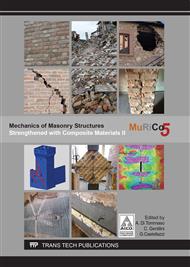p.472
p.480
p.488
p.496
p.504
p.512
p.518
p.525
p.533
Numerical Evaluation of Mechanical Parameters Role in GFRP Strengthened Cobblestone Masonry Walls
Abstract:
The use of a GFRP (Glass Fiber Reinforced Polymers) mesh, embedded as a reinforcement in a mortar coating on both wall sides, proved to be effective and reliable in increasing the masonry wall resistance and the plastic deformation capacity.In this study, a NL finite element model, developed to predict the in-plane behaviour of masonry walls strengthened by means of this technique, is refined and used in an extensive parametric study. Numerical results were compared with diagonal compression test data on URM and RM cobblestone masonry samples, showing good agreement. The masonry panel and the mortar coating were modelled as isotropic homogeneous materials with a smeared crack approach, whereas the GFRP reinforcement was modelled as a mesh of truss elements. Properties assigned to materials were derived from experimental tests.The parametric study performed before on some involved mechanical properties, considering a standard range of variation, is now extended to other parameters. Moreover, the combined variation of different properties is considered. The actual contribute of each component (masonry, GFRP mesh, mortar) on some macroscopic parameters (strength and ductility of the specimen) is evaluated.The parametric analysis highlights the important role of the GFRP mesh not only on the peak load increment but also on the post-peak behavior and, in particularly, on the ductility increment of the reinforced masonry panel. These results can address the optimization of the intervention technique and the deliverable of operative guidelines for practitioners.
Info:
Periodical:
Pages:
504-511
Citation:
Online since:
July 2017
Authors:
Price:
Сopyright:
© 2017 Trans Tech Publications Ltd. All Rights Reserved
Share:
Citation:


